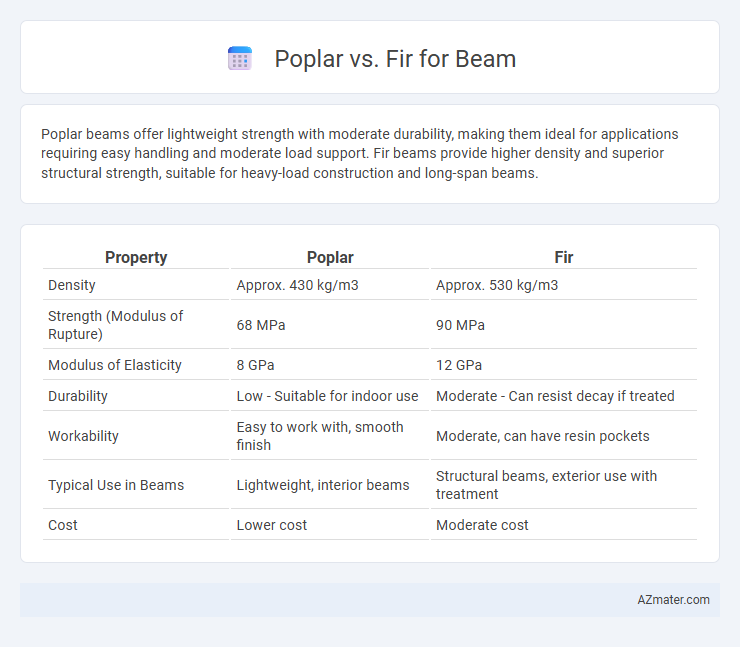Poplar beams offer lightweight strength with moderate durability, making them ideal for applications requiring easy handling and moderate load support. Fir beams provide higher density and superior structural strength, suitable for heavy-load construction and long-span beams.
Table of Comparison
| Property | Poplar | Fir |
|---|---|---|
| Density | Approx. 430 kg/m3 | Approx. 530 kg/m3 |
| Strength (Modulus of Rupture) | 68 MPa | 90 MPa |
| Modulus of Elasticity | 8 GPa | 12 GPa |
| Durability | Low - Suitable for indoor use | Moderate - Can resist decay if treated |
| Workability | Easy to work with, smooth finish | Moderate, can have resin pockets |
| Typical Use in Beams | Lightweight, interior beams | Structural beams, exterior use with treatment |
| Cost | Lower cost | Moderate cost |
Introduction to Poplar and Fir as Beam Materials
Poplar is a lightweight hardwood known for its moderate strength, smooth texture, and easy workability, making it suitable for non-structural beams or interior applications where flexibility and cost-efficiency matter. Fir, particularly Douglas fir, is a strong, resilient softwood renowned for high load-bearing capacity, dimensional stability, and resistance to warping, making it ideal for structural beams in construction. The choice between Poplar and Fir beams depends on factors like required strength, durability, aesthetic preference, and specific use in building frameworks.
Poplar vs Fir: Wood Characteristics Overview
Poplar features a lightweight, fine-grained structure with moderate strength and excellent workability, making it easy to cut and shape for beam applications. Fir exhibits higher density and superior strength, providing greater load-bearing capacity and durability in structural beams. Choosing between poplar and fir depends on balancing ease of handling with structural performance requirements.
Strength and Structural Performance Comparison
Poplar wood offers moderate strength with a tensile strength around 36 MPa, making it suitable for lightweight beam applications, while fir boasts higher tensile strength typically near 44 MPa, enhancing its load-bearing capacity and structural performance. Fir beams exhibit superior stiffness and dimensional stability, which reduces deflection under load, whereas poplar's lower density results in less rigidity, limiting its use in high-stress structural components. The structural efficiency of fir makes it a preferred choice for construction requiring robust, durable beams capable of supporting substantial weight and resisting environmental strain.
Durability and Resistance to Decay
Poplar wood offers moderate durability and resistance to decay, making it suitable for indoor beam applications where moisture exposure is limited. Fir, especially Douglas fir, exhibits superior durability and natural resistance to decay, performing well in structural beams with higher exposure to outdoor elements. Choosing fir beams enhances longevity in moisture-prone environments, while poplar remains a cost-effective option for dry, interior settings.
Workability and Ease of Handling
Poplar beams offer superior workability due to their softer texture and uniform grain, making them easier to cut, shape, and fasten with standard woodworking tools. Fir, while slightly harder, provides good dimensional stability but may require more effort to machine and handle, especially in thicker beam sizes. For projects prioritizing ease of handling and quick fabrication, poplar is often favored over fir.
Cost and Availability of Poplar vs Fir
Poplar beams generally offer a lower cost compared to fir due to their faster growth rates and higher availability in many regions. Fir, while often more expensive, provides greater structural strength and durability, which can impact overall project budgets depending on performance requirements. Availability of poplar is typically higher in eastern parts of the United States, whereas fir is more prevalent and readily sourced in the Pacific Northwest markets.
Aesthetic Differences: Color and Grain
Poplar beams feature a light, creamy color with subtle green or brown streaks, offering a smooth, uniform appearance that complements modern and minimalist interiors. Fir beams exhibit warm reddish-brown hues with a prominent, straight grain pattern, creating a rustic and natural aesthetic ideal for traditional or cabin-style designs. The distinct color contrast and grain texture between poplar and fir influence the visual impact and style of exposed wooden beams in construction and decor.
Environmental Impact and Sustainability
Poplar beams have a lower environmental impact due to their rapid growth rate and high carbon sequestration capacity compared to fir, which grows more slowly. Fir beams, although durable, require longer forest regeneration times, making poplar a more sustainable choice for reducing deforestation pressures. Sustainable forestry practices for both species enhance their ecological benefits, but poplar's faster harvest cycle and ability to thrive in varied climates contribute to better resource efficiency and reduced habitat disruption.
Best Applications for Poplar and Fir Beams
Poplar beams are ideal for interior construction projects where lightweight and moderate strength are needed, such as furniture frames, cabinetry, and decorative beams, due to their fine grain and ease of machining. Fir beams excel in structural applications requiring high strength and durability, including roof trusses, floor joists, and heavy framing, because of their superior load-bearing capacity and resistance to warping. Choosing between poplar and fir depends on the specific project demands, with poplar suited for aesthetic and light structural uses and fir preferred for robust, heavy-duty frameworks.
Conclusion: Choosing the Right Wood for Your Beams
Poplar offers lightweight, easy handling, and cost-effectiveness, making it suitable for interior beams with moderate load requirements. Fir provides superior strength, durability, and resistance to warping, ideal for structural beams in heavy-load or outdoor settings. Selecting Fir ensures long-term stability and safety, while Poplar is preferred for budget-conscious, aesthetic applications where minimal structural stress is expected.

Infographic: Poplar vs Fir for Beam
 azmater.com
azmater.com